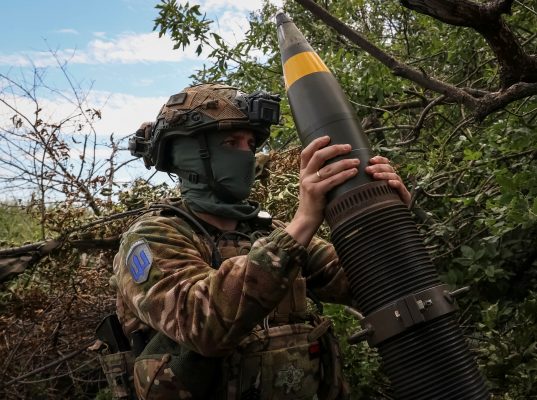This article is part of CEPA’s “Age of Autonomy” series, which looks at the growing use and implementation of autonomous technologies on the battlefield and its implications for transatlantic defense and security.
The modernization of defense is now more than ever a race for technological superiority between near-peer competitors. The successful development, deployment, and integration of emerging and disruptive technologies, such as autonomy capabilities, are already having a profound impact on theaters of conflict.
Since the end of the Cold War, the United States and its NATO allies have enjoyed a technology lead over both state and non-state adversaries.
However, this gap is shrinking, due to the transatlantic alliance’s two-decade “strategic pause” on defense innovation during the Global War on Terror, growing defense innovation efforts by Russia and China, and the shift of research and development spending from governments to the private sector. Simply put, NATO and its regional partners are no longer the main drivers of new defense technologies and have even fallen behind their competitors in key emerging technology areas. As competition with Russia and China captivates the West, an urgent need exists for transatlantic leaders to target key technological priorities and construct a common policy framework.
After the Cold War, the United States and its allies shifted their focus to combating terrorism and capacity-building in fragile states. The urgency to develop and field new technologies to combat potential near-peer competitors eroded. Without this motivation, NATO—especially its larger members—continued to develop and acquire complex, bespoke platforms, which typically assumed permissive operating domains, such as billion-dollar satellites, multi-billion-dollar aircraft carriers, and GPS-dependent ground and air assets. This approach incrementally improved capabilities, but yielded no game-changing technologies.
At the same time, research and development spending shifted from parity between the private sector and government R&D (a ratio of approximately 1:1 in 1990) to almost five times in favor of the private sector in 2022. Critical emerging and disruptive technologies (EDTs) and techniques of gathering information and intelligence moved from the providence of the governments to the private sector. Traditionally, defense-focused EDTs were the product of major defense research organizations or the Primes—the largest aerospace and defense manufacturers working directly for militaries or governments. Due to the R&D shift, this is increasingly no longer the case. Private companies match and even surpass government capabilities, including in areas that were/are considered innately government functions.

This trend is particularly true for autonomous capabilities. These capabilities include not just unmanned systems (across all warfighting domains), but also applied autonomy for C2, intelligence collection and processing, and other functions. They have played a critical role in the Ukraine war, with both Russia and Ukraine leveraging a mix of military and modified commercial off-the-shelf solutions to do everything from intelligence, surveillance, and reconnaissance (ISR) missions to delivering kinetic effects against personnel and assets. This marks a notable shift to afforadable mass on the battlefield, away from the aforementioned bespoke assets. Both Ukrainian and Russian forces rely on additional sources of information and insight to inform these missions. These efforts are bolstered by tech-enabled platforms and connectivity to illuminate the environment and then hardware-based assets to execute the mission.
The private sector, including start-ups and scale-ups, plays an outsized role. For example, in the US SpaceX’s Starlink satellite service has become a key tool for Ukraine to communicate on the battlefield. Similarly, in Europe, for instance, Munich-based Quantum Systems is providing differentiated, mission-critical unmanned systems for dozens of use cases, while London-based Labrys is driving real-time insights and response in the rapidly changing threat environment. The development and growth of companies like these are critical to the Ukraine war. They will be even more instrumental in any future conflict between great powers. Companies like these survive and thrive via the freedom to develop, deploy, and iterate on new capabilities in real-time. While the private capital markets in Europe lag behind the United States and China (due to a number of structural issues, including ESG concerns), there is a small, but growing number of investors supporting this sector. These include the UK’s MD One, the first European national security and defense venture capital (VC) firm, and Germany’s Project A Ventures, an early-stage, pan-European generalist VC. Both are actively investing in European defense tech. However, these funds and the aforementioned companies need broader support.
Striking a Balance
Many government and civil society stakeholders are arguing that the development of artificial intelligence-based defense tools should be slowed in order for regulations to catch up, or even want to institute blanket bans on autonomous weapons. Such a ban is unrealistic and risks leaving the West behind. Strict regulations on autonomy in defense will stifle innovation and hinder the development of advanced technologies that could enhance national security.
Instead, a flexible regulatory framework is required, suited to enable rapid adaptation of autonomous systems capable of addressing evolving threats, providing defense agencies with the agility needed to maintain a technological edge. By iterating and honing, autonomous systems will improve precision, reduce collateral damage, and enhance overall efficiency in military operations. Striking a balance between ensuring the ethical use of autonomous systems and fostering technological advancements in defense is crucial, thus careful consideration of the potential opportunities and challenges is essential before implementing restrictive measures.
Overall, there is no way to put Pandora back in the box. Instead of attempting to stymie progress, governments should focus on stress testing potential flexible rules of engagement (ROE) for autonomous capabilities. Western companies will continue to develop best-in-breed technologies to compete with adversaries. Governments should define the rules of engagement. Together, the private and public sectors can help us meet the Chinese challenge.
Nicholas Nelson is an experienced leader in aerospace and defense (A&D), working at the nexus of innovation and national security. At CEPA he serves as Senior Fellow for Emerging Tech & Policy. In addition to his work at CEPA, Mr. Nelson’s research and analysis is focused on emerging defense and dual-use technologies. He also advises a range of deep tech venture-backed startups.
Europe’s Edge is CEPA’s online journal covering critical topics on the foreign policy docket across Europe and North America. All opinions are those of the author and do not necessarily represent the position or views of the institutions they represent or the Center for European Policy Analysis.





